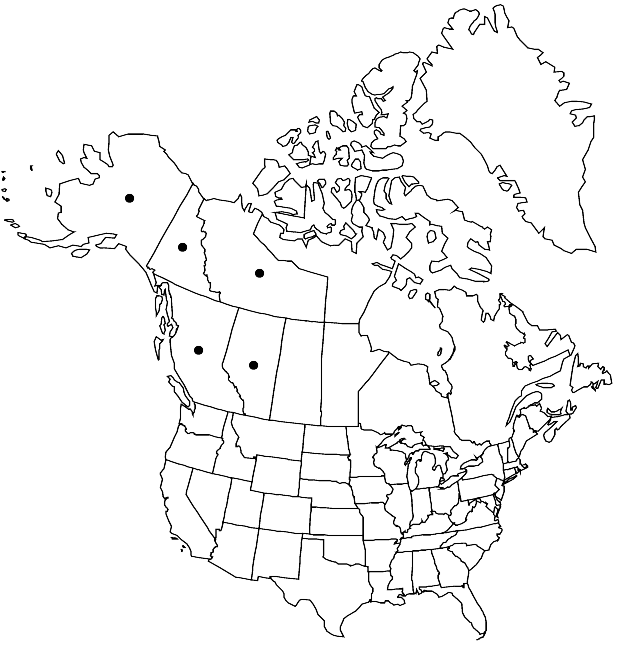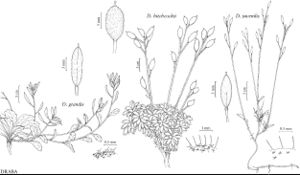Difference between revisions of "Draba juvenilis"
Repert. Spec. Nov. Regni Veg. 13: 167. 1914.
FNA>Volume Importer |
FNA>Volume Importer |
||
| Line 11: | Line 11: | ||
|name=Draba hirta var. tenella | |name=Draba hirta var. tenella | ||
|authority=Eastwood | |authority=Eastwood | ||
| + | |rank=variety | ||
}} {{Treatment/ID/Synonym | }} {{Treatment/ID/Synonym | ||
|name=Draba kananaskis | |name=Draba kananaskis | ||
|authority=G. A. Mulligan | |authority=G. A. Mulligan | ||
| + | |rank=species | ||
}} {{Treatment/ID/Synonym | }} {{Treatment/ID/Synonym | ||
|name=Draba longipes | |name=Draba longipes | ||
|authority=Raup | |authority=Raup | ||
| + | |rank=species | ||
}} | }} | ||
|hierarchy=Brassicaceae;Brassicaceae tribe Arabideae;Draba;Draba juvenilis | |hierarchy=Brassicaceae;Brassicaceae tribe Arabideae;Draba;Draba juvenilis | ||
| Line 42: | Line 45: | ||
-->{{#Taxon: | -->{{#Taxon: | ||
name=Draba juvenilis | name=Draba juvenilis | ||
| − | |||
|authority=Komarov | |authority=Komarov | ||
|rank=species | |rank=species | ||
| Line 57: | Line 59: | ||
|publication year=1914 | |publication year=1914 | ||
|special status= | |special status= | ||
| − | |source xml=https://jpend@bitbucket.org/aafc-mbb/fna-data-curation.git/src/ | + | |source xml=https://jpend@bitbucket.org/aafc-mbb/fna-data-curation.git/src/f50eec43f223ca0e34566be0b046453a0960e173/coarse_grained_fna_xml/V7/V7_418.xml |
|tribe=Brassicaceae tribe Arabideae | |tribe=Brassicaceae tribe Arabideae | ||
|genus=Draba | |genus=Draba | ||
Revision as of 22:16, 16 December 2019
Perennials; (not pulvinate); caudex branched (branches slightly loose, with persistent leaf remains, sometimes terminating in sterile rosettes); often scapose. Stems unbranched, (0.3–)0.8–2.3(–3) dm, pubescent proximally, glabrous or sparsely pubescent distally, trichomes simple and 2–4-rayed, 0.07–0.4 mm. Basal leaves (loosely) rosulate; petiolate; petiole base ciliate, margin not ciliate, (midvein obscure, trichomes simple and 2-rayed, 0.2–0.7 mm); blade oblanceolate to lanceolate, (0.3–)0.6–2.5(–3.5) cm × (1–)2–7(–10) mm, margins entire or denticulate, surfaces pubescent, abaxially with stalked, cruciform trichomes, 0.2–0.5 mm, adaxially with cruciform and/or simple and 2-rayed ones. Cauline leaves 0–2 (or 3); sessile; blade elliptic to ovate or lanceolate, margins usually entire, rarely denticulate, surfaces pubescent as basal adaxially or trichomes predominantly simple. Racemes (2–)4–13(–18)-flowered, ebracteate, elongated in fruit; rachis not flexuous, glabrous or sparsely pubescent as stem. Fruiting pedicels divaricate-ascending or ascending, straight or often curved upward (not expanded basally), (3–)5–17(–22) mm, usually glabrous, rarely pubescent, trichomes simple and stalked, 2–4-rayed. Flowers: sepals ovate, 2.2–3 mm, glabrous or pubescent subapically, (trichomes simple and short-stalked, 2-rayed); petals pale yellow to creamy white, spatulate, 3–5 × 1.5–2.5 mm; anthers ovate, 0.4–0.5 mm. Fruits elliptic to oblong or linear-lanceolate, plane (not curved), flattened, 5–11(14) × 2–3 mm; valves usually glabrous, rarely margin pubescent, trichomes simple; ovules 16–30 per ovary; style 0.2–0.7 mm. Seeds oblong, 0.7–1.2(–1.5) × 0.4–0.7(–0.8) mm. 2n = 64.
Phenology: Flowering Jun–Jul.
Habitat: Rock outcrops, talus, gravelly beaches and stream banks, meadows, tundra
Elevation: 0-2700 m
Distribution

Alta., B.C., N.W.T., Yukon, Alaska, e Asia (Russian Far East, n Siberia).
Discussion
Although Draba kananaskis and D. longipes have often been treated as distinct species, we find no basis for maintaining them. Both exhibit variations in petal color (white to pale yellow) and leaf trichomes (short-stalked to sessile) characteristic of D. juvenilis from the Russian Far East. Perhaps most importantly, all three are octoploids (2n = 64) with x = 8. We conclude that D. kananaskis is nothing more than a minor variant of D. juvenilis and it is treated herein, for the first time, as a synonym of that species.
Draba juvenilis is occasionally confused with D. borealis, which also has stalked, cruciform trichomes with unbranched rays. Typical D. juvenilis is easily distinguished from that species by having narrower (2–3 mm) fruits that are glabrous (rarely pubescent) and untwisted, and 0–2 (or 3)-leaved stems. By contrast, D. borealis has wider (2.5–4.5 mm) fruits that are usually pubescent and/or twisted (rarely neither) and (2 or) 3–7(–12)-leaved stems.
Selected References
None.
